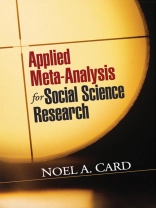Offering pragmatic guidance for planning and conducting a meta-analytic review, this book is written in an engaging, nontechnical style that makes it ideal for graduate course use or self-study. The author shows how to identify questions that can be answered using meta-analysis, retrieve both published and unpublished studies, create a coding manual, use traditional and unique effect size indices, and write a meta-analytic review. An ongoing example illustrates meta-analytic techniques. In addition to the fundamentals, the book discusses more advanced topics, such as artifact correction, random- and mixed-effects models, structural equation representations, and multivariate procedures. User-friendly features include annotated equations; discussions of alternative approaches; and ‘Practical Matters’ sections that give advice on topics not often discussed in other books, such as linking meta-analytic results with theory and the utility of meta-analysis software programs.
表中的内容
I. The Blueprint: Planning and Preparing a Meta-Analytic Review 1. An Introduction to Meta-Analysis 1.1 The Need for Research Synthesis in the Social Sciences 1.2 Basic Terminology 1.3 A Brief History of Meta-Analysis 1.4 The Scientific Process of Research Synthesis 1.5 An Overview of the Book 1.6 Practical Matters: A Note on Software and Information Management 1.7 Summary 1.8 Recommended Readings 2. Questions That Can and Questions That Cannot Be Answered through Meta-Analysis 2.1 Identifying Goals and Research Questions for Meta-Analysis 2.2 The Limits of Primary Research and the Limits of Meta-Analytic Synthesis 2.3 Critiques of Meta-Analysis: When Are They Valid and When Are They Not? 2.4 Practical Matters: The Reciprocal Relation between Planning and Conducting a Meta-Analysis 2.5 Summary 2.6 Recommended Readings 3. Searching the Literature 3.1 Developing and Articulating a Sampling Frame 3.2 Inclusion and Exclusion Criteria 3.3 Finding Relevant Literature 3.4 Reality Checking: Is My Search Adequate? 3.5 Practical Matters: Beginning a Meta-Analytic Database 3.6 Summary 3.7 Recommended Readings II. The Building Blocks: Coding Individual Studies 4. Coding Study Characteristics 4.1 Identifying Interesting Moderators 4.2 Coding Study “Quality” 4.3 Evaluating Coding Decisions 4.4 Practical Matters: Creating an Organized Protocol for Coding 4.5 Summary 4.6 Recommended Readings 5. Basic Effect Size Computation 5.1 The Common Metrics: Correlation, Standardized Mean Difference, and Odds Ratio 5.2 Computing r from Commonly Reported Results 5.3 Computing g from Commonly Reported Results 5.4 Computing o from Commonly Reported Results 5.5 Comparisons among r, g, and o 5.6 Practical Matters: Using Effect Size Calculators and Meta-Analysis Programs 5.7 Summary 5.8 Recommended Readings 6. Corrections to Effect Sizes 6.1 The Controversy of Correction 6.2 Artifact Corrections to Consider 6.3 Practical Matters: When (and How) to Correct: Conceptual, Methodological, and Disciplinary Considerations 6.4 Summary 6.5 Recommended Readings 7. Advanced and Unique Effect Size Computation 7.1 Describing Single Variables 7.2 When the Metric Is Meaningful: Raw Difference Scores 7.3 Regression Coefficients and Similar Multivariate Effect Sizes 7.4 Miscellaneous Effect Sizes 7.5 Practical Matters: The Opportunities and Challenges of Meta-Analyzing Unique Effect Sizes 7.6 Summary 7.7 Recommended Readings III. Putting the Pieces Together: Combining and Comparing Effect Sizes 8. Basic Computations: Computing Mean Effect Size and Heterogeneity around This Mean 8.1 The Logic of Weighting 8.2 Measures of Central Tendency in Effect Sizes 8.3 Inferential Testing and Confidence Intervals of Average Effect Sizes 8.4 Evaluating Heterogeneity among Effect Sizes 8.5 Practical Matters: Nonindependence among Effect Sizes 8.6 Summary 8.7 Recommended Readings 9. Explaining Heterogeneity among Effect Sizes: Moderator Analyses 9.1 Categorical Moderators 9.2 Continuous Moderators 9.3 A General Multiple Regression Framework for Moderation 9.4 An Alternative SEM Approach 9.5 Practical Matters: The Limits of Interpreting Moderators in Meta-Analysis 9.6 Summary 9.7 Recommended Readings 10. Fixed-, Random-, and Mixed-Effects Models 10.1 Differences among Models 10.2 Analyses of Random-Effects Models 10.3 Mixed-Effects Models 10.4 A Structural Equation Modeling Approach to Random- and Mixed-Effects Models 10.5 Practical Matters: Which Model Should I Use? 10.6 Summary 10.7 Recommended Readings 11. Publication Bias 11.1 The Problem of Publication Bias 11.2 Managing Publication Bias 11.3 Practical Matters: What Impact Do Sampling Biases Have on Meta-Analytic Conclusions? 11.4 Summary 11.5 Recommended Readings 12. Multivariate Meta-Analytic Models 12.1 Meta-Analysis to Obtain Sufficient Statistics 12.2 Two Approaches to Multivariate Meta-Analysis 12.3 Practical Matters: The Interplay between Meta-Analytic Models and Theory 12.4 Summary 12.5 Recommended Readings IV. The Final Product: Reporting Meta-Analytic Results 13. Writing Meta-Analytic Results 13.1 Dimensions of Literature Reviews, Revisited 13.2 What to Report and Where to Report It 13.3 Using Figures and Tables in Reporting Meta-Analyses 13.4 Practical Matters: Avoiding Common Problems in Reporting Results of Meta-Analyses 13.5 Summary 13.6 Recommended Readings References Author Index Subject Index About the Author
关于作者
Noel A. Card Ph D, is Associate Professor in Educational Psychology at the University of Connecticut. His areas of interest include child and adolescent social development and quantitative research methods. He has received the Society for Research in Child Development Early Career Research Contributions Award and is an elected member of the Society of Multivariate Experimental Psychology.












